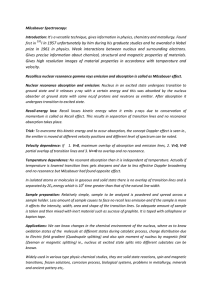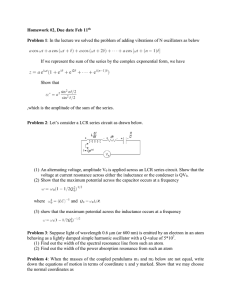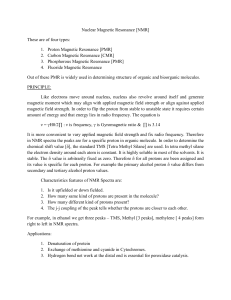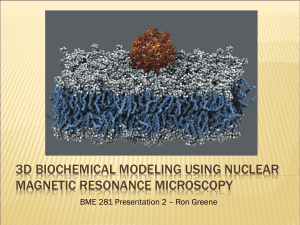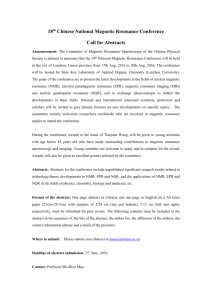--- .. ~~.- -- -.
advertisement
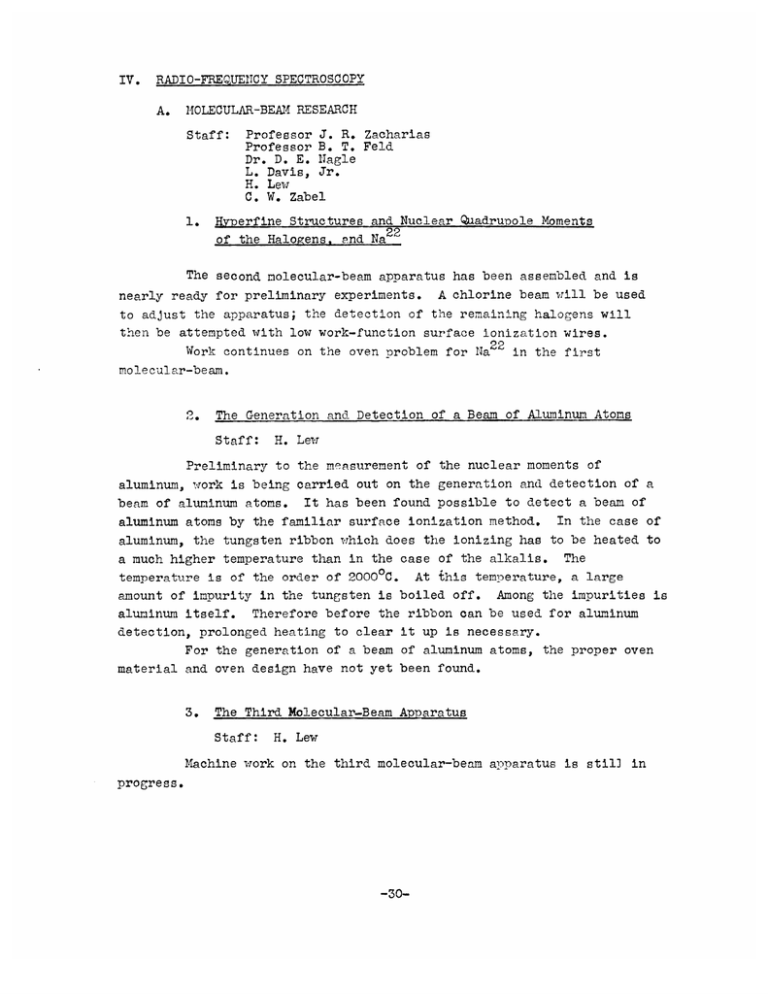
--- IV. ..~~.---. ~~--I I --r~--- --rr^l-"--------^ ^------ "-^~I"-rl-III~LP~ RADIO-FREQUEINCY SPECTROSCOPY A. MOLECULAR-BEM4 RESEARCH Staff: 1. Professor J. R. Zacharias Professor B. T. Feld Dr. D. E. Nagle L. Davis, Jr. H. Lew C. W. Zabel Hyperfine Structures and Nuclear Quadrupole Moments of the Halogens, and Na2 2 The second molecular-beam apparatus has been assembled and is nearly ready for preliminary experiments. A chlorine beam will be used to adjust the apparatus; the detection of the remaining halogens will then be attempted with low work-function surface ionization wires. Work continues on the oven problem for Na2 2 in the first molecular-beam. 2. The Generation and Detection of a Beam of Aluminum Atoms Staff: H. Lew Preliminary to the measurement of the nuclear moments of aluminum, work is being carried out on the generation and detection of a beam of aluminum atoms. It has been found possible to detect a beam of aluminum atoms by the familiar surface ionization method. In the case of aluminum, the tungsten ribbon which does the ionizing has to be heated to a much higher temperature than in the case of the alkalis. The temperature is of the order of 20000C. At this temperature, a large amount of impurity in the tungsten is boiled off. Among the impurities is aluminum itself. Therefore before the ribbon can be used for aluminum detection, prolonged heating to clear it up is necessary. For the generation of a beam of aluminum atoms, the proper oven material and oven design have not yet been found. 3. The Third Molecular-Beam Apparatus Staff: H. Lew Machine work on the third molecular-beam apparatus is still in progress. -30- _I _L^I~LI^-P-_-l _~j^_/^ Il^l)_____X ~~__ll__Il~ 4. Theory of Nuclear Effects in Microwave Spectra Staff: Professor B. T. Feld G. Knight A theory has been developed for the fine structure of the rotational levels of slightly asymmetric top molecules due to nuclear The wave functions for the asymmetric top electric quadrupole moments. were expanded in terms of the symmetric top wave functions and a parameter representing the degree of asymmetry of the molecule. The nuclear quadrupole coupling was evaluated to first order in the asymmetry parameter. The result introduces, in addition to the term usually obtained for symmetric tops, a term involving the difference between the gradients of the electric field with respect to the minor axes. The results are of the same form as those obtained by Bragg with the difference that the result can be expressed in terms of a simple formula involving the molecular and nuclear constants and the quantum 3 cos r3 9 - 1) 1J( - 1 is: The result for K numbers J and K of the molecule. = 311 2 + 2J J+ 3 - 1 aI2 - b[G(JK) + G(J-)j4 a 2V where G(J,K) (J + K + 1)(J + K + 2)(J - K - 1)(J - K) 8(K + 1)(J + l)(2J + 3) and b = (A- B)/20 - (A + B) ; A, B, and C are the reciprocal principle moments of inertia. For the case of K = + 1, the general expressions obtained are no longer valid since these states are degenerate in terms of the representation employed, and the perturbation due to the quadrupole term fails to remove this degeneracy. 1. In this case degenerate perturbation theory has J. K. Bragg, Bull. Am. Phys. Soc. 23, No. 2, G10 (January 29, 1948). .._.. ~~.-- ...-1Ylll.~i~-I .I---. -P~r. .LCI1--II..~C-~ -.1I~~~~1II_~~~___ _~~~~-__I_ been applied and similar results obtained. This work was reported at the New England Section Meeting of the American Physical Society held at Harvard on May 29, 1948. B. MAGNETIC NUCLEAR RESONAIICE Staff: 1. Professor F. Bitter N. L. Alpert C. G. Lehr H. L. Poss Measurements of Nuclear Magnetic Moments Staff: H. L. Poss In previous progress reports, precision measurements were reported in which the deuteron moment and those of the thallium isotopes were compared with the proton moment. Further measurements of this type have been completed for C1 3 and F1 9 C13 is a stable isotope of carbon occurring naturally in an abundance of 1.1 per cent. Its gyromagnetic ratio had been measured previously by molecular-beam methods. The availability of a sample of methyl iodide enriched in C1 3 prompted measurements to be made on it. A hollow polystyrene coil form was made into which could fit the sealed-off glass tube containinr, the methyl iodide, a liquid. A second coil was used to obtain a reference proton resonance at 17.9 Mc/sec., the C resonance then being expected to occur at 4.5 Mc/sec. Each coil was part of a bridge circuit of the type we have described in the last progress report. A search using a recording output meter revealed a weak resonance in the expected vicinity. It was attributed to C1 3 since there were no other nuclei in the sample which would give resonances in this region. Measurements were mpde by recording the C1 3 resonance at a known frequency and then obtaining the proton resonance :ith the second coil in the same position as that formerly occupied by the C1 3 sample. The magnet field current was kept constant throughout. The C1 3 resonance was traversed by varying the current through a set of auxiliary coils on the magnet. From the calibration of these coils, a small correction could be made for the field difference separating the two resonances. The result of seven determinations of the ratio of resonant frequencies is VC 13/ = 0.25143 + .00005 -32- . py ~IC--~---~----- The spin of ~-~------~ 13 is known to be . Taking 5.5791 + .0016 for the gyro- magnetic ratio of the protonland applying a small correction for the diamagnetism of the electrons surrounding the carbon nucleus gives the result, in nuclear magnetons, l 13 0.7016 + = .0004 . Most of the error results from the uncertainty in the proton gyromagnetic ratio. The value is well within the limit of error of the molecularbeam result, 013 0.701 + .002 . = Fluorine exists in the form of a single isotope of mass number 19. Its high gyromagnetic ratio together with the existence of suitable samples enables its resonance to be observed readily on the oscilloscope. It was decided to apply the resonance-absorption method to the measurement of its moment to see how the results would compare with the observed molecular-beam value. Hydrofluoric acid was used as a sample. Since it affects glass, it could not be kept in the vials used for other samples. It does not affect polystyrene, however, and was poured directly into the coil forms. A series of measurements was made in the vicinity of 19 Mc/sec. One sample coil was used. The field was kept constant and the frequency varied so that first the proton resonance was obtained and then the fluorine one. The resonance frequencies are sufficiently close together so that one bridge circuit could be used for both. Four determinations give for the ratio of resonance frequencies = SF19/ 0.94077 + .0001 . The spin of F19 is known to be . Taking into account a small diamagnetic correction and using the previously referred to value of the proton gyromagnetic ratio give the result, in nuclear magnetons, L ! 1. = 2.626 + .001 , S. Millman and P. Kuech; Phys. Rev. 60, 91 (1941). New values incorporating corrections due to a change in the accented moment of the electron [see J. Schwinger, Phys. Rev. 73, 416 (1948)may be computed by using gp = 5.5858. -33- --LI-1II~^__II~_C~__~D -----l L- - -C-X^1- *-~~I) l.^-----rr _,~..,~r.r~-c~lrrru-^- the error again arising mostly from that in the gyromagnetic ratio of the proton. The result is in good agreement with the molecular-beam value 19 Fl = 2.627 ± .003 A tabular summary of the measurements we have thus far made is given below. Nucleus Observed ratio of g-factor to that of the proton Magnetic moment in nuclear magnetons H2 .153511 + .000003 .85645 ± .00025 C1 3 .25143 ± .00005 F1 9 .94077 + .0001 2.626 T1203 .571499 ± .00005 1.612 .577135 + .00005 1.628 .7016 + .0004 ± .001 1-2 0 5 L 2 0 3 = 1.00986 205 T1 ± .00005 A full report of this work is to be found in a thesis by H. L. Poss, entitled "Measurements of Nuclear Magnetic Moments", and will appear shortly in the Physical Review. 2. Studies of Phase Transitions by Means of Magnetic Nuclear Resonance Phenomena Staff: N. L. Alpert During the past quarter considerable data have been obtained on the line width of the proton resonance in solids at low temperatures. Attention was concentrated on those substances which show more than one phase in the solid state. The resultant data, of which the graphs for HG1 and HBr are illustrative (Figs. TV-i and IV-2), enable us to interpret the mechanism of these well-known phase transitions. In order to clarify the interpretation of the results, we shall discuss briefly the factors which affect the resonance line width for the cases studied. Under the conditions of the experiment, the line width is determined by the magnetic interaction between nuclei. Since in general the neighbors of a magnetic nucleus are themselves magnetic, they will contribute to a local magnetic field H1 oo at the nucleus in question, which field will add to, or subtract from, the applied d-c field, Ho . U) (14 :, (.9 I I 4 a 0 TK Fig. IV-1. Line width vs. temperature for the proton resonance in HC1. I I II \ I SOLID jI IIl, oI HBr I LiQUID I SOLDI II SOUD I 0o 100 I 120 140 IGO 10 200 T OK Fig. IV-2. Line width vs. temperature for the proton resonance in HBr. In both cases the transition temperatures separating the two or more solid phases and the melting points are indicated. -35- --rr- . -~-~--.I .._I~~,~, -~-- ----- ~'-~~~~~~~-~' -~1C~--~~' -.-I-1----~-~' -1X1 - I-~-i~-I- That is, we may say that the magnetic field at a nucleus is H o + Hlo 0 0 and that the resonance condition is then w = Y(Ho + Hloc) where w is the resonant angular frequency and 7 the nuclear gyromagnetic ratio. A simple calculation shows that these internuclear fields may be of the order of several gauss. The result is thus a dispersion of the magnetic fields at the various nuclei about the applied H , the average field at the nuclei still being Ho . From the resultant broadening of the Zeeman levels, AE = -yHloc, we may define a time T2 on the basis of Hlo the uncertainty principle of quantum mechanics: T2 = T./AE = l/j 1 0. Since this broadening is due to interactions betwreen nuclei, T2 is called the spin-spin relaxation time. It should be noted that Hlo c represents a deviation of the magnetic field from an average Ho . Therefore, gradients in the magnetic field due to the inhomogeneity of the magnet serve also to broaden the line. Most solids are found to fit well with this extremely elementary picture, giving resonance line widths of five or more gauss. In fact, for many cases the line width may be accurately estimated by computing the mean square local magnetic field, summing over contributions from all neighbors. However, in the case of most liquids and gases and a few solids, line widths of a small fraction of a gauss are found. The key to these narrowr resonances is the lattice motion, which we have so far neglected. Qualitatively the resonance line width is reduced by an averaging out of the inter-nuclear fields due to the motion of the lattice which carries the nuclei. This is particularly obvious in the extreme case of a nucleus residing in a freely rotating molecule, since rotational periods are much smaller than times associated with the nuclear resonance. In most cases of interest all orientations are equally probable. As a consequence the internuclear fields essentially average out to zero, resulting in an extremely narrow line. Actually in the case of water a line width of 10- 4 gauss is predicted. In practice it is impossible to observe this "true" line width since it would require, at a working field of 7000 gauss, a homogeneity of almost one part in 108 over the sample. Thus the line width in most licuids is determined entirely by the homogeneity of the magnet. A theory of line widths and relaxation times by Bloembergen, Purcell, and Pound1 approximates this description of the lattice motion by . This so-called correlation time is means of a single parameter 1. I. Bleombergen, E. M. Purcell, and R. V. Pound, Phys. Rev. 73, 679 (1948). essentially the average time for a molecule to change its position or orientation appreciably. It is very closely related to the "characteristic relaxation time" introduced by Debye in his theory of polar molecules. 1 The effect of 4c on T2 and on the line width may be seen as follows: Let us denote by T2 " the spin-spin relaxation time in the limiting case of the rigid lattice. Thus, for this case, T2 " represents the average time a nucleus spends in a particular Zeeman energy state (or orientation). Now if c>> T2"the slow variation of the internuclear fields during the "lifetime" of a nuclear orientation will have a negligible effect on the spin-spin interaction. Therefore we have Case I: Tc > T T2 = T2 AH = 1/yT2 " If on the contrary T7 44 T2", considerable averaging out of the internuclear fields occurs during a normal nuclear level "lifetime". As a result the spin-spin interaction is greatly reduced and the relaxation time increased accordingly. In this case it may be shown that, in general, the relaxation time varies inversely as the correlation time. Case II: ' (< TS" T2 c 1/IAH oc T c Thus it becomes apparent that the line Width is a sensitive function of the correlation time. It is this fact that makes this method useful in the study of the class of phase transitions considered, since these may possibly be explained in terms of a change in molecular activity. There are two conflicting theories to explain the transitions in question. One theory, put forward by Pauling2 and Fowler , associates the transition temperatures with a change from rotational oscillations of the molecules or ionic groups below the critical temperature to a phase in which most of the molecules are freely rotating. The second theory, developed by Frenkel 4 and Landau5 assumes that the transition is from 1. 2. 3. P. Debye, "Polar Molecules", Dover, New York (1945). L. Pauling, Phys. Rev. 36, 430 (1930). 4. R. H. Fowler, "Statistical iechanics", Second Edition, New York (1946),Ch. XXI. J. Frenkel, "Kinetic Theory of Liquids", Oxford (1946), 5. L. Landau, Phys. Z. de So-wjetunion 11, 26, -37- 545 (1937). acmillan, Ch. II. In this theory there is assumed a preferred orientation, occupied by a majority of the molecules, below the transition,,fwhile above the transition the molecules occupy with an ordered to a disordered state. It equal probability one of two, or more, equilibrium orientations. should be noted that both below and above the transitions the molecules betreen eouilibrium orientations. An investigation of orders of magnitude involved indicates the in the range from about is a measure of ?r The line iidth following: flin the magnitude of T 2 , down to about 0.1 itsec, as limited by the homogeneity of the magnet. For the case of rotating molecules, one seconds or less, while for should expect characteristic times of 10 10 ILsec, normal solids one should expect characteristic times of a microsecond or more, a difference of at least 104 The expected effect of phase transitions may now be discussed on For the case of a the basis of the ex.ected values of To" and re. rotational transformation the line should be broad, typical of most solids, below the transition; upon reaching the transition, where free rotation becomes predominant, one should expect a rapid decrease, over the range of the transition to a narrow line limited in width only by magnet inhomogeneity. Howrever, in the case of an order-disorder transition, there may be little or no change in 7c at the transition temperaThat is, if a moderate change, or zero change in line width occurs at the transition, this must be identified with the order-disorder mechanism. On the contrary, if a rapid change to a very narrow line ture. occurs at the transition, the rotational transfornation mechanism may be indicated, although the order-disorder mechanism is not completely ruled out on the basis of this evidence alone. Complete curves of line width versus temperature have recently All of these were found to been obtained for HC1, HBr, HI, H 2 S, and H 2 Se. have the same fundamental characteristics as shown in Figs. IV-1 and IV-2 for HC1 and HBr. Therefore, in these cases the phase transitions cannot possibly be associated with the onset of molecular rotation but satisfy, instead, the conditions of an order-disorder transformation. Preliminary results for IH401, NH4 Br, NH 4 I, and KH 2 P0 4 indicate that transitions in these solids also fall in the same classification. In those cases studied in detail, a narrow line, limited only by the magnetic field, was found in a temperature range of roughly 20 K below the melting point. this This indicates extraordianary activity in these solids, but since is does not set in at the transition, the Pauling-Fowler interpretation still out of the question for these cases. -38- In a few cases, reported in the July 15 and October 15, 1947, Quarterly Progress Reports, results indicate the plausibility of a rotational transformation, although the order-disorder mechanism is not absolutely eliminated for these transitions. These exceptional solids are CH4 and CH3 D, as well as natural rubber, for which internal rotation is shown to be reasonable but is not unquestionably proved. These experiments iwere carried on in a cryostat constructed especially for this purpose. The temperature of the sample is controlled by means of a variable heat leak. Temperatures from 800 to 160 0 K can be obtained by using liquid nitrogen as a low-temperature reservoir; from 1500 to 180 0 K by using pumped liquid ethylene; and from 1700 to 2600 K by using liquid ethylene boiling under atmospheric pressure. The samples which were not available commercially were prepared by Dr. C. S. Pearsall of this Laboratory and his staff. The invaluable discussions with Professor L. Tisza on the theoretical background of this problem are gratefully acknowledged. A detailed report of this research is to be submitted in the near future for publication in the Physical Review. 3. Circuit Improvement Staff: L. G. Lehr A summary of this work is contained in the last progress report. A complete report is available in a master's thesis in the Department of Electrical Engineering entitled, "Eouipment for the Measurement of Nuclear Magnetic Resonances". C. PARA~GITETIC AND FERROI!AGNETIC RESOINi!CE ABSORPTION Staff: Professor A. F. Kip R. D. Arnold E. Lebow Experimental apparatus for use in the 1-cm and 3-cm wavelength regions has been improved with the view of making possible more accurate resonance half-width determinations. The problem of relating the magnetic field for apparent resonance maximum, as measured by reflection of power from a cavity containing a sample, to the field for true maximum absorption of the sample alone is being studied. The difference between these two quantities becomes important under some conditions when the absorption curve is broad. A number of paramagnetic salts have been tested, including some tests to extend measurements to 10-cm wavelengths. -39- ---c----~.__~~ ,.~.~....~..llr--^--- .. -c----- - A sample of annealed permalloy has been tested (with one test run at liquid N 2 temperature) for the purpose of further investigating the anomalous value of the g factor which has been obtained for various iron samples in other laboratories. Some details are given below. Measurements at 10-cm Wavelength. Work in this frequency range on paramagnetic salts has been so far limited to the study of powders. This has been due to limitations on sensitivity caused by the large size of a simple 10-cm resonant cavity as compared to the size of the usually available single crystals. Modification of cavity design will allolr small single crystals to be studied at 10 cm at a later date. Measurements on CuSO 4 5H 2 0 powdergive results which are consistent with our earlier results Chromic potassium alum and ferric alum powders have also been tested at 10 cm, but useful interpretations of the results will be possible at 3 cm. only when single crystal measurements can be made. Permallov. A sample'of annealed permalloy (loaned to us by the Bell Telephone Laboratories) is now being tested. Since permalloy has essentially no anisotropy, determination of the g factor is somewhat simpler than in the case of the single crystal of iron which we have previously tested. The frequency for resonance absorption in iron, according to the equation of Kittel, is proportional to (BH)2. Since the proper value to use for B is somewhat uncertain, we are testing the sample at both 1 and 3 cm, equation. in order that B may be eliminated from the Difficulty in the exact evaluation of g has been encountered This difficulty due to the rather large width of the resonance of the sample. is being resolved and it is believed that an accurate evaluation of the g factor will soon be available. D. MICROWAVE SPECTROSCOPY Professor A. G. Hill Professor G. G. Harvey Dr. Y. Beers Dr. R. L. Kyhl Dr. M. W. P. Strandberg R.,E. Hillger J. G. Ingersoll R. B. Lawrance C. C. Loomis M. Weiss The study of molecular absorption in the microwave region has already covered a wide area of problems. Techniques for observing the absorption have been studied and developed, but the main effort has been directed to a study of the use of absorption data. Various types of absorptions and molecules have been studied so that a wrorking familiarity with the broad field of microwave spectroscopy has been developed. -40- _____I__1I__ICl__llm_ ~.~._ In order to put the work continuing at present in proper perspective, it is well to review some past work done at this Laboratory. The ammonia inversion, or vibration, absorption has been studied in conjunction with others in the field. Precise frequencies were measured for some 30 transitions to serve as frequency standards in the 1 - 1.5 cm region. The nuclear quadrupole interaction was also studied and has been reported. The oxygen band of absorption at 5 mm has been investigated at high pressures and this research is being written for publication in the near future. This absorption is due to electron spin-rotational orbit interac- tion. Pure rotational absorption in linear molecules has been studied in the case of 0CS and OCSe. The 008 work has been published as RLE Tech- nical Report No. 59, and the report on 0CSe work is in preparation. The OCSe analysis has shown that in addition to molecular structure, the nuclear spin, and quadrupole information, absorption measurements may be used to deduce vibration frequencies, isotopic abundances, dipole moments, and variation of dipole moments with vibrational statequadratic and cubic vibration potential force constants, and as yet to a limited degree, the mass of atoms themselves. Work on very asymmetric molecules as H 2 0 and HDO has also shown that even in these complicated molecules, measurements of the dipole moment, change of dipole moment with rotational state, and in HDO even the HOD angle for each rotational state may all be measured with facility. This work will also be published as an RLE report. Work has also been done on the problem of observing absorptions at high temperature, to allow observation of substances that are solids at room temperature, and also the rotational absorption of molecules in highly excited vibrational states. Although this work was delayed for some time, it is expected to yield results in the near future. Work in rotational absorption due to nearly symmetric tops such as pyridine is being continued to allow the analysis of a rather complicated absorption scheme with a complex molecule. Such a study will provide a yardstick with which to measure the analytic ability of microwave spectroscopy. Some studies of system sensitivity have been made and it appears that absorption coefficients a 1 of the order of 10-8 cm- 1 may be measured with ease, and that with more difficulty, i.e., - 1 second, a's of 10 10cm -1 may be measured. observation times of the order of This is very close to the theo- retical limit of sensitivity. 1. The reduction in power in an electromagnetic wave in passing through an absorbing gas a distance 4 is given as P = P eo -41- a . -^--ul1.Y^-.~...;- ------ ---l c-- ---- - --1-1-" --1- -~- ~"~~-^--~----h Work is continuing on the problem of expanding the scope of microThis work has been discussed in the previous wave absorption measurements. The cavity system being assembled is designed progress report and continues. to allow absorption studies to be made with small samples of gas, for example, containing radioactive nuclei. Since the sample is so compact, studies of the absorption in gases in a strong magnetic field, i.e., the Zeeman effect, will also be pursued with this apparatus. Finally, considerable progress has been made in extending the useful frequency range over which absorptions may be studied. A system using as a power source the third harmonic energy produced in a non-linear silicon crystal which is driven with 1-cm klystron power has been completed. This system at present can detect absorption in the 60,000 to 90,000 Mc/sec region and it will allow us to observe rotational spectrum of light molecules, and to extend considerably the region over which absorption data on heavier molecules may be taken. A search has been made for the J = 0 to 1 transition in the roThis was thought to provide a contation spectrum of formaldehyde (H2 CO). venient first molecule for the 60,000 to 90,000 Mc/sec system. The molecule behaves almost like a linear rotor, and the infrared vibration spectrum has been resolved so that the transition in question is accurately predicted to Two strong lines were observed at 72,470 Mc/sec and fall at 72,900 Mc/sec. 72,810 Mc/sec. dehyde vapor. Commercial paraformaldehyde was used as the source of formalThe two lines can hardly be explained by a doubling of the line being sought. Tests are continuing. amplitude has been obtained to 86,000 Mc/sec This offers by quadrupling from 21,500 Mc/sec, using the tripling components. Mc/sec 120,000 to hope that intense lines may be observable soon in the 90,000 A signal of useful range. Work on atomic absorption spectra is also continuing in the ceasium and hydrogen measurements. Until we obtain results, we shall emphasize the experimental rather than interpretational features of the problem. Several runs have been attempted in order to measure the hydrogen hyperfine structure, but apparatus difficulties have prevented the obtaining of results so far. Steps are being taken to remedy the troubles (mainly with an FM receiver) and a clean run should be possible very soon. The yield of atomic hydrogen from the r-f arc source has been measured, by using the heating effect when recombination takes place on a platAt the time of the measurements it was found inum foil inside the cavity. that slightly over 30 per cent of the molecules were dissociated; since that time, there is reason to believe that this yield has been doubled. It was observed that electrolytic zinc apparently does not recombine atomic hydrogen drastically, a fact which may be of use to other experimenters. -42- II--I~II~--L-LI-L- --_-CI-_-_- ..__, Work on caesium hyperfine absorption spectrum recently has been resumed after a lapse of several months. There are, however, no new results to report. The principal problem continues to be the construction of leakproof cavities. Cavities of two different designs are being built; one containing a vacuum-tight quartz container; the other with a mica window with a water-cooled cement joint. Some improvement has been made in the circuits for stabilizing oscillators. A study of fluctuations in the apparatus has also been made. -43-


